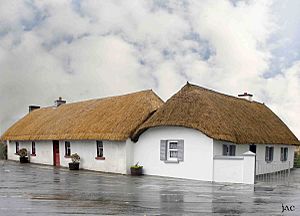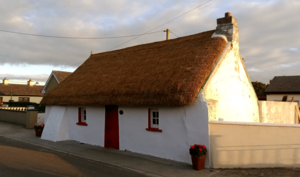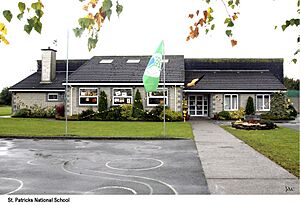Clogh, County Kilkenny facts for kids
Quick facts for kids
Clogh
An Chloch
|
|
|---|---|
|
Village
|
|

Thatched building in Clogh
|
|
| Country | Ireland |
| Province | Leinster |
| County | County Kilkenny |
| Population
(2022)
|
298 |
| Time zone | UTC+0 (WET) |
| • Summer (DST) | UTC-1 (IST (WEST)) |
| Irish Grid Reference | S5627678602 |
Clogh (which means "The Stone" in Irish) is a small village in County Kilkenny, Ireland. It is also the name of a local area used for elections and a townland within the larger area of Castlecomer.
Contents
Where is Clogh Located?
Clogh is found on the R426 road, not far from Castlecomer. It is about 27 km north of Kilkenny city. Other nearby towns include Carlow (16 km away), Portlaoise (25 km away), and Athy (20 km away).
The village is part of the Clogh Electoral Division. This division covers about 0.83 square miles. Clogh shares borders with several other townlands, like Aughatubbrid or Chatsworth and Moneenroe.
A Look at Clogh's History
In 1837, Clogh was a busy place with 116 houses. Most of these homes had traditional thatched roofs. About 582 people lived there, and many worked in the nearby coal mines. There was also a police station in the village.
The name Clogh comes from the Irish words An Chloch, meaning "stone" or "stone building". Some history suggests there was once a castle in a field nearby. This castle might be where the village got its name.
People and Coal Mining
In 2022, Clogh had a population of 298 people. In the past, many more people lived here. This was mainly because of the local coal mines, which offered many jobs.
Coal mining in the area started way back in the 1640s. The coal found here was a special type called anthracite. It was known for being very good quality. The Leinster coalfields, where Clogh is located, also spread into counties Laois and Carlow.
By the late 1800s, there were several mines operating. Later, in the 1920s, the Deerpark Mines opened. At its busiest, this mine employed 600 people! Some coal mining families from Clogh even moved to Pennsylvania in the United States. This happened during and after the Great Famine (1845–1851). The mines in the Clogh area finally closed in 1969.
Important Buildings and Heritage
The first church in Clogh was built in the 13th century. The church building you see today was built in 1826. Its graveyard has old monuments, including one for Michael Fenlon. He built an early steam engine for a nearby coal mine in the 1790s.
There are still three beautiful thatched buildings left in Clogh. These traditional houses are a special part of the village's history.
At the village crossroads, there is a water pillar. People still use it to get water from a well in the nearby area of Aughatubbrid or Chatsworth.
Local Facilities
Clogh has a local primary school called St. Patrick's National School. The current school building was built in the 1990s. The older school building, from 1915, is now used as a community centre. In 2024, about 66 students attended St. Patrick's National School.
The last shop in Clogh closed in April 2024.
Getting Around Clogh
You can reach Clogh by bus using Local Link routes. Bus 838 connects Clogh to Mountmellick/Portlaoise and Kilkenny. Bus 822 connects Clogh to Mountmellick and Carlow.
See also
 In Spanish: Clogh - Chatsworth para niños
In Spanish: Clogh - Chatsworth para niños





